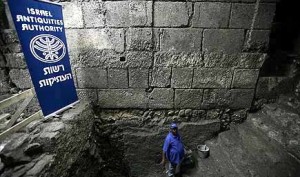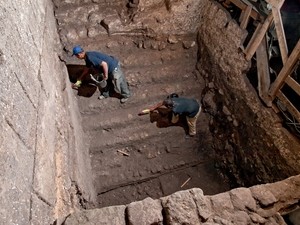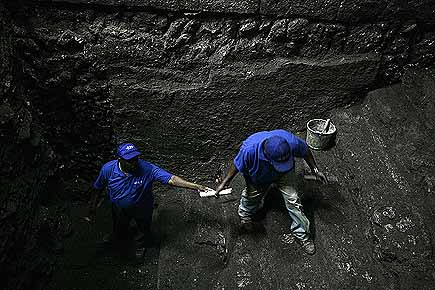 Jerusalem – A 2,000-year-old mikveh (ritual bath) has been uncovered just 20 meters from the Western Wall.
Jerusalem – A 2,000-year-old mikveh (ritual bath) has been uncovered just 20 meters from the Western Wall.
Subscribe to our Daily Roundup Email
Given its location just outside the Holy Temple – where untold numbers of Jews regularly immersed before entering – the newly-revealed pool is among the largest ever discovered in Jerusalem.
The mikveh was found at the site known as the Western Wall Tunnels, which has long been under excavation and study by the Israel Antiquities Authority, with the support of the Western Wall Heritage Foundation.

It is located about 30 meters past the entrance to the Tunnels, in the general direction of the Western Wall. Once it becomes open to the public, the 11 broad steps leading down to the mikveh will be seen approximately 8 meters below floor level.
Josephus, the famous turncoat general and historian of the period, wrote that the administrative and governmental center of Jerusalem was located at the foot of the Temple, and that among the buildings there were the National Council and the Lishkat HaGazit, Chamber of Hewn Stone, where the Sanhedrin – Israel’s Supreme Court – convened.
The archaeologists feel that it is possible that the luxurious hall aside the mikveh was originally one of these structures.
Archaeologist Alexander Ohn, the director of the dig, explains:
“It is interesting to note that in the middle of the first century, changes were made in the grand structure. It was no longer used for public administrative purposes, and in its western wall a large mikveh was installed – with 11 steps descending into the immersion pool. It appears that Jerusalem was growing at this time, and with it the need to provide a solution for the increasing numbers of people who came en masse to Jerusalem, especially on the pilgrimage festivals (Passover (Pesach), Pentecost (Shavuot), and Tabernacles (Sukkot)). Ritual immersion in a mikveh and precise observance of the laws of purity were an inseparable part of Jewish life at this time; the importance of a mikveh, especially in this location, was great.”
Parts of the mikveh had been uncovered in the past, but now another hall – one of three – has been revealed. The structure was built of smooth stone hewn in a particularly intricate manner, with high-quality decorations and architectural style.
Its importance can be determined by the fact that it is similar to other luxurious structures built by King Herod such as the Temple Mount, the Machpelah Cave, and one in Elonei Mamreh.


when can i go in!!!!
wow!!!
imagine taking a quick dip then off to the Kotel for some davening!
powerful.
Beautiful!
and the best part is…is that it is boir all gabei boir
what do you mean?!? off to the kosel? it would have been THE BEIS HAMIKDASH!!! NOW THATS POWERFUL
Be sure, the Israeli government has no plans to open the mikveh for use. There is a far older mikveh that can be used at the kever of Shmuel Ha Navi, just outside Jerusalem.
where do you see bor al gabei bor
It was probably just one Bor. The rainwater probably entered that one pit and they immersed directly into it. Cold and dirty.
bor al gabei bor is in order to assure that the actual mikveh in which you inmerse yourself ( where the water could be changed) is considered as if you inmersed in the bor of pure rain water, but if you inmere yourself in the only one mikveh of rain water or water from a well like in the Ariza”l’s mikveh in Tzfas you don’t need bor al gabei bor.
They find more and more but it still dosent wake up there nishmos to do tishuva let them dig in there owen self they will find a big find that is lost
Wow. I’m not really a mikvah goer but I would toivel there!
OK, bor al gabei bor is nice, and chasidic innovations in halacha are all very interesting, but let’s stop pretending that chasidus is of ancient origin.
Is there a shower with free shampoo and towels?
Is there a turnstile? where did they swipe the cards? Does the sign on the wall say “Please do not leave towels on the floor”? These have been passed down midor li’dor